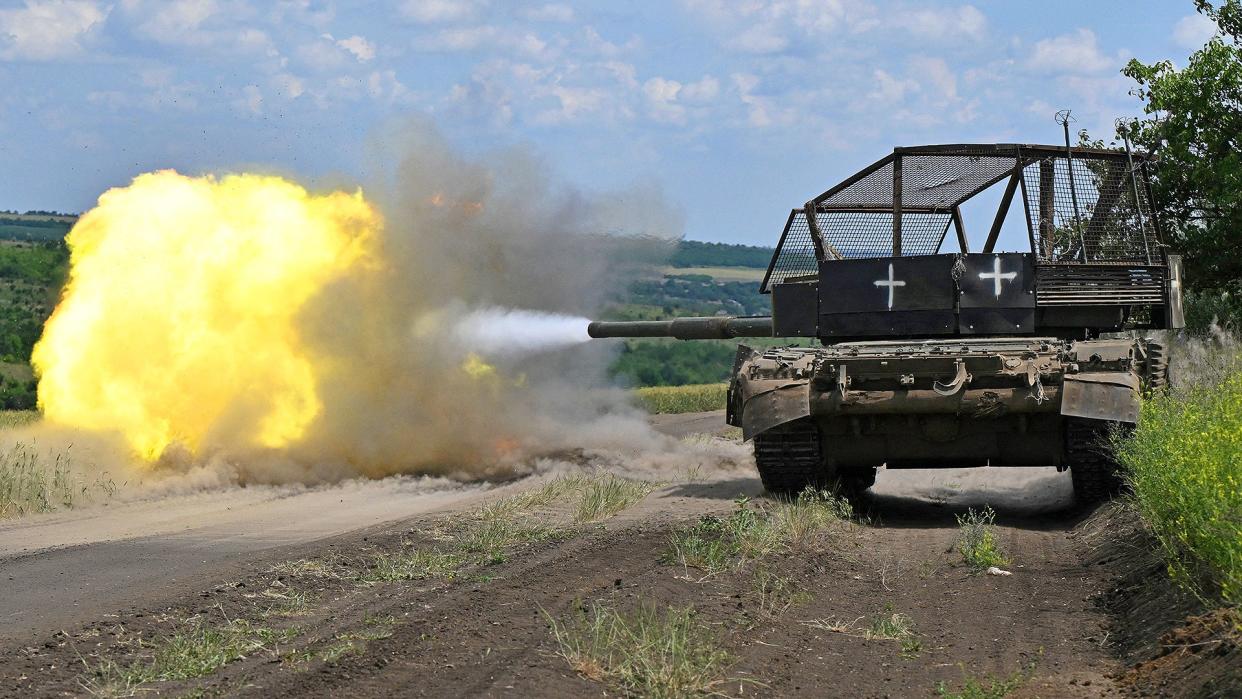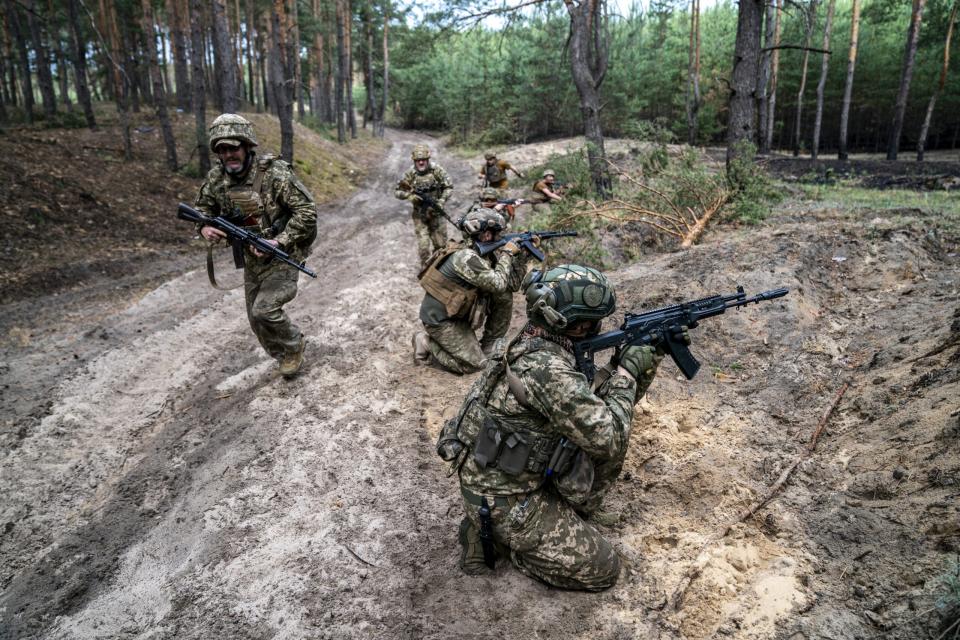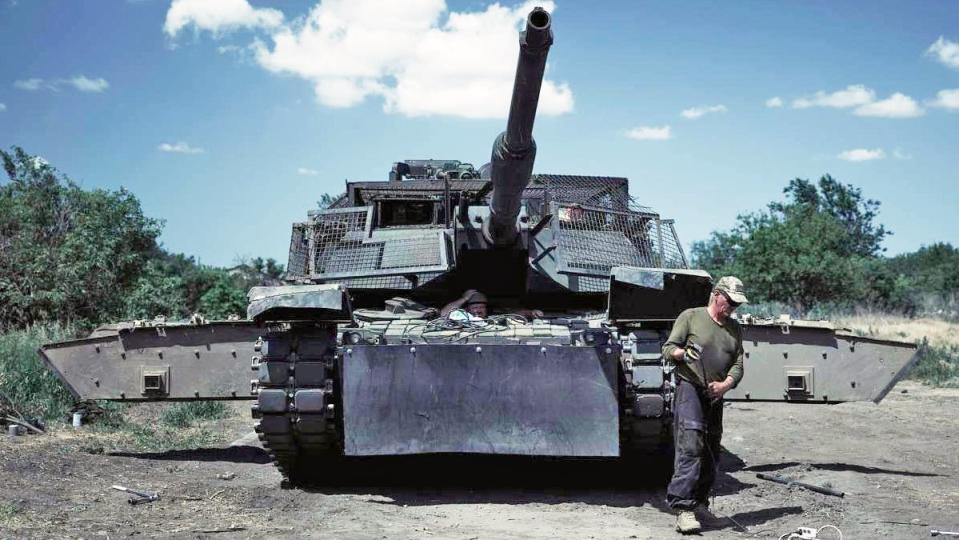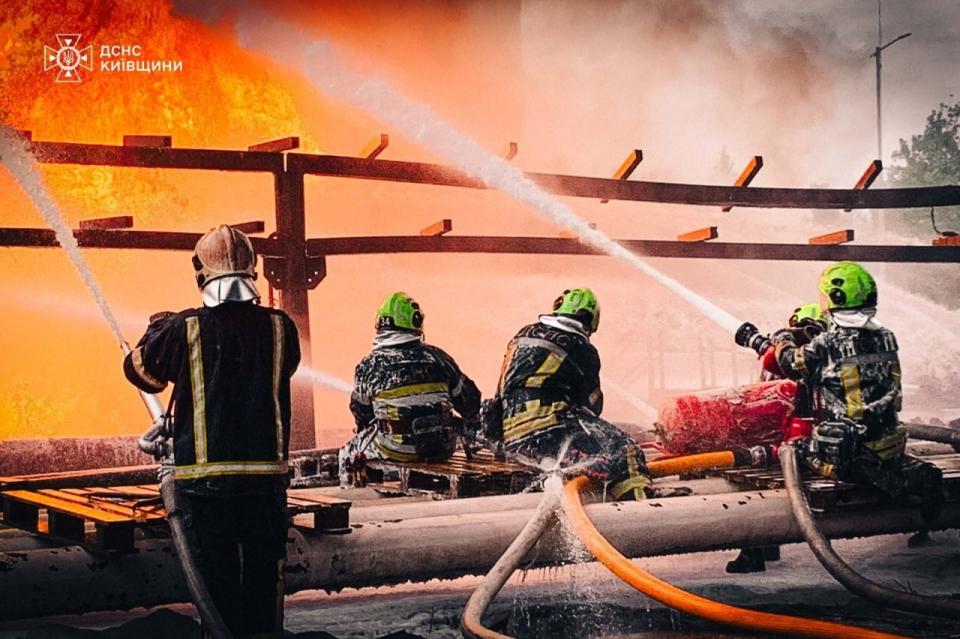Ukraine Situation Report: Dueling Peace Plans That Are Worlds Apart

- Oops!Something went wrong.Please try again later.
- Oops!Something went wrong.Please try again later.
- Oops!Something went wrong.Please try again later.
By the time Ukrainian President Volodymyr Zelensky arrived in Switzerland for an international peace conference, his counterpart in Russia had delivered a plan of his own, touching on oft-repeated themes.
Kyiv must drop its desire to join the NATO alliance and hand over four oblasts claimed by Moscow, Russian President Vladimir Putin said at a meeting with Foreign Ministry senior officials Friday.
“The conditions are very simple," Putin said, demanding the full withdrawal of Ukrainian troops from all of the Donetsk, Luhansk, Kherson, and Zaporizhzhia oblasts in eastern and southern Ukraine.
Those four oblasts have been claimed by Russia, whose forces currently control about 20 percent of Ukraine, mostly in those regions. Moscow illegally annexed Crimea in 2014.
"As soon as they declare in Kyiv that they are ready for such a decision and begin a real withdrawal of troops from these regions, and also officially announce the abandonment of their plans to join NATO - on our side, immediately, literally at the same minute, an order will follow to cease fire and begin negotiations," Putin said, according to Reuters.
"I repeat, we will do this immediately. Naturally, we will simultaneously guarantee the unhindered and safe withdrawal of Ukrainian units and formations."
As if to remind Kyiv that he is not bluffing, Putin told the Foreign Ministry officials that Russia has about 700,000 troops in Ukraine, the official Russian news agency TASS reported on its Telegram channel Friday.
Ukrainian and U.S. officials dismissed the Putin plan as an unwanted ultimatum.
“It is clear he (Putin) understands that there will be the peace summit,” Zelensky told Italy's SkyTG24 news channel before departing for Switzerland. “It is clear he understands the majority in the world are on Ukraine's side, on the side of life. And on the eve of the summit, amid air raid sirens, the killing of people and missile attacks, he speaks as though he is issuing some sort of ultimatum," he told the news outlet.
Zelensky drew historical parallels between Putin’s demands and Nazi dictator Adolf Hitler’s 1938 insistence that Czechoslovakia hand over a large part of its nation to Germany.

“What can we say about these ultimatum messages?” he added. “They are no different from the other ultimatums that were made before. We now see that it is a renaissance of Nazism. It is a new wave of this Nazism, because it is a Russian Nazism. What Putin declares is that we should give back a part of our occupied territories, but also unoccupied ones. He says he's gonna stop and there'll be no frozen conflict. They are the same messages that Hitler sent, it has not even been 100 years since he asked only a part of Czechoslovakia saying that he would then stop.“
Zelensky arrived in Switzerland Friday on the eve of the Global Peace Summit, a gathering of about 100 nations to map out a way forward for an acceptable resolution of the war in Ukraine, now in its third year.
"Arrived in Switzerland for the Global Peace Summit," he said on social media. "There are two days of active work ahead with countries from all corners of the world, with different peoples who, however, are united by a common goal - to bring a just and lasting peace for Ukraine closer."
The conference on Saturday and Sunday is structured around elements of a 10-point peace formula first presented by Zelensky in late 2022, The Associated Press reported.
Chief among those points are the withdrawal of all Russian troops from Ukrainian territory and cessation of hostilities, restoration of Ukraine’s territorial integrity, punishing Russia for war crimes, and release of all prisoners and deportees.
However, it is seen as a largely symbolic effort on the part of Kyiv to rally the international community and project strength against Russia.
Looming over the summit, however, is how Ukraine and Russia will achieve peace when Moscow isn't attending.
Speaking to reporters after a NATO defense ministers meeting in Brussels, U.S. Defense Secretary Lloyd Austin dismissed the Putin plan.
“Putin has illegally occupied sovereign Ukrainian territory,” said Austin. “He is not in any position to dictate to Ukraine what they must do to bring about peace...We don't want to see a leader of one country wake up one day and decide that he wants to erase borders and annex the territory of his neighbor. That's not the world that any of us want to live in.”
Putin, he added, “could end this war today. He started this war with no provocation. He's had some hundreds thousands of troops wounded and killed in this unjust and unprovoked invasion. He could end this today, if he chose to do that, and then we call upon him to do that and to leave Ukrainian sovereign territory.”
https://www.youtube.com/watch?v=WajBLpg28_E
While there is talk of peace, there are few indications that it will happen anytime soon. Meanwhile, the Russian attacks on Ukrainian cities continue unabated.
Before diving into more developments from the conflict in Ukraine, The War Zone readers can review our previous coverage here.
The Latest
At a press conference after Zelensky and U.S. President Joe Biden signed a new, long-term security accord at the G7 summit in Italy on Thursday, the Ukrainian President hinted that his Air Force might get squadrons of jets in addition to the dozens of F-16 Vipers already promised.
The agreement "clearly states that America supports Ukraine's efforts to win this war," Zelensky said at a post-signing press conference. "The agreement includes provisions for advanced defense systems like Patriot and fighter jet squadrons—that’s right, plural, squadrons—including, but not limited to, F-16s."
Zelensky didn't specify what kind of jets or where they would come from, but there have been limited assurances of any fighters other than Vipers. France promised a half dozen Mirage 2000-5 fighters while there are supposedly questionable plans in the works for Argentina to transfer five French-made Super Etendard naval strike aircraft to Ukraine. The U.S. has promised no jets to Ukraine.
The Pentagon on Friday declined to speculate on Zelensky's comments.
"We’re not going to speak for President Zelensky or try to interpret his comments, nor can we speculate on any future announcements before they’re made (and we have none for today)," a Pentagon official responded in an email. The White House did not respond to our request for comment.
The U.S.-Ukrainian agreement was also “very specific about the supply of the necessary weapons, joint production and strengthening defense industries of our countries through our cooperation, and this is something that will...provide...new good jobs for Ukrainians and Americans,” Zelensky said.
https://youtu.be/kz-lycMNUE8?t=5119
During the summit, Zelensky asked for more than a half-dozen Patriot systems.
"We need seven Patriot systems — yes, to save our cities — not all of them; it’s a pity — but urgently seven," he said. "And we discussed the possibility of having five of them, it’s true. But the partners work on it."
Patriot air defense systems are in extreme demand. Zelensky's ask comes at a time when America has committed many of its own batteries to locales around the world, especially to the Middle East in response to the ongoing Israel-Gaza crisis. The Pacific is also of great concern. If a crisis were to erupt there, every available battery would be needed. As we explained in our deep dive into the subject, all this underscores the stark limitations of even America's own Patriot capacity. As a result, there are very few places to drum up additional batteries without the source nation really accepting greater risk. Israel is one such place that has surplus Patriot batteries, but there is no indication they are willing to transfer them to Ukraine, even though the United States, although it is possible.
Biden said that five nations he did not name have promised Ukraine Patriots and other air defense systems and that other nations needing U.S. air defense systems are out of luck.
"We let it be known to those countries that are expecting from us air defense systems in the future that they’re going to have to wait," Biden said. "Everything we have is going to go to Ukraine until their needs are met. And then we will make good on the commitments we made to other countries."
U.S. Defense Secretary Lloyd Austin told reporters Thursday morning that there are no Patriot batteries for Kyiv in the immediate pipeline from America. The U.S. has already supplied one battery to Kyiv.
“I don't have any announcements on Patriot batteries today,” Austin said when asked if the U.S. will supply Ukraine with a system in addition to the one already provided. Austin was speaking after the 23rd meeting of the Ukraine Defense Contact Group, a consortium of some 50 nations working to keep Kyiv armed in its fight against Russia.
Austin also shot down claims in a New York Times story that the new Patriot would come from Poland.
“I've seen some of the press reporting,” Austin said. “What I will tell you is that there will be no change in our Patriot coverage in Poland. I know that that was a component of a previous story there, but there is no change in our basic coverage.”
While there is no guarantee that Ukraine will receive additional squadrons of jets or Patriot batteries, one thing is clear.
Zelensky will continue asking for them as Ukraine desperately tries to fend off Russian advances.
The situation on the front lines “is somewhat more stabilized now than it was over the past several weeks,” Joint Chiefs Chairman Air Force Gen. C.Q. Brown told reporters Thursday morning at the post-UDCG press conference. “One of the things that the Ukrainians have been focused on over the past several months, going into 2024, is filling out their defensive lines, and they've been fairly effective at building those defensive lines, which has created a bit of stability.”
The Russian push toward Kharkiv, Ukraine’s second-largest city, has complicated matters, he added.
“It actually pulls away focus and capability from other areas and spreads their offenses a little bit more,” Brown said. “But what we've seen is the Ukrainians have been very good at holding their defensive lines, and we'll be able to do that there in Kharkiv as well.”

The Biden administration's recent decision to allow Ukraine to conduct limited strikes inside Russia has helped their defense of Kharkiv, Austin said.
“The intent of allowing them to conduct counter fire was to help them address the issue of Russians building staging areas in just on the other side of the border, and attacking from those staging areas,” he said. You can see one of those attacks, on Russian air defenses in Belgorod, in the video below.
“I see a slowing of the Russian advance and a stabilizing of that particular piece of the front now," added Austin. "A couple of weeks ago, there was concern that we would see a significant breakthrough on the part of the Russians. I don't think we'll see that going forward. I don't think I don't see a large exploitation force that could take advantage of a breakthrough."
Permission by the U.S. and other nations for Ukraine to donated weapons on Russian soil sparked a furious rebuke from Kremlin’s Security Council Deputy Chairman, Dmitry Medvedev, the Kyiv Post reported.
Addressing the recent threat by President Vladimir Putin to provide weapons to Moscow’s allies that are capable of striking those countries that support Ukraine, Medvedev wrote: "Are they [the West] afraid of us handing over our weapons to the enemies of the Western world? We must transfer all possible types of weapons except, for now, nuclear ones!”
Germany on Friday announced a major tranche of military aid to Ukraine that includes two badly needed IRIS-T air defense systems, three MARS II rocket launchers (the German version of the U.S. M270 Multiple Launch Rocket System.), 10 Leopard 1A5 main battle tanks, 20 Marder Infantry Fighting Vehicles, 21,000 rounds of 155mm ammunition and much more.
Canada began deliveries of armored vehicles to Ukraine.
"The first four of 50 new armored vehicles built by Canadian workers for Ukraine are heading to Ukraine’s Armed Forces today," Canadian Minister of National Defense Bill Blair wrote on Twitter.
Member of Parliament Peter Fragiskatos "@PFragiskatos saw the vehicles loaded onto trucks – and this summer, Ukrainian troops will be trained in their use," he added. "These state-of-the-art armored vehicles will fulfil a wide variety of roles on the battlefield. The first ten are armoured ambulances, which come with medical equipment and armour that will enable Ukraine’s troops to safely evacuate and treat wounded personnel."
Ukraine has become the first country to create a new stand-alone branch of the military dedicated to drone systems, known as the Unmanned Systems Forces, ABC News reported.
It was an initiative growing out of the importance of drones on the battlefield
“We have a strong prospect for victory in the war against Russia," First Deputy Defense Minister Ivan Havryliu said during a presentation. "This victory can be achieved through your intelligence, perseverance, and the steps you take to protect the lives and health of our servicemen by increasingly employing robots and unmanned systems in the air, on the ground, and at sea,” said Havryliuk.
Images emerged from that presentation of Ukrainian drones similar to the Iranian-made Shahed 136s that Russia has been using since October 2002 to attack cities, power infrastructure, and other facilities.
Ukraine is reportedly developing standardized 40mm high-explosive fragmentation munitions for its drones. In the past, many of the munitions dropped or attached by small drones have been improvised or repurposed, which sometimes included sawing open cluster munitions canisters and other dangerous tasks.
Ukrainian Special Operations Forces (SSO) say they destroyed a Russian R-416GM digital radio relay station with a drone. It marked the first such destruction of Russia’s newest communication station, SSO claimed on its Telegram channel. The system, first fielded in 2018, is designed to increase the efficiency of radio relay communications units in the field, SSO said.
You've seen numerous videos of First Person-View (FPV) drones from both sides creating havoc. A Scripps Howard journalist recently spent time with one of Ukraine's FPV units and showed how they hunt down individual troops.
"Fuck, this gets me high," said one soldier, wearing his goggles as he guides a drone in a chase to find and and eliminate a Russian.
These Russian troops in the video below were motoring down a road in Ukraine in a convertible when their vehicle was hit by a Ukrainian FPV drone.
At about 20 seconds in, it appears the Russians spotted the drone and seconds later, it struck, overturning the vehicle and setting it ablaze. Most of the Russians seemed to have survived, though it is unclear whether there were any injuries or deaths.
The Russian troops in this FPV drone video were apparently not as fortunate. You can see the drone approaching a vehicle with about a half-dozen Russian troops aboard. Just as the drone reaches the target, the video cuts to another drone view showing a massive fireball from the resulting explosion engulf the vehicle
A Russian a Su-30SM Flanker is seen in a recent video reportedly firing at a Ukrainian drone over Vladimir Oblast in Russia, which is located about 400 miles northeast of the border. The video shows the Flanker firing an air-to-air missile, but the drone is never seen and the outcome of the engagement is unknown.
It's becoming harder to hide from drones even at night. Ukraine's Khorne Group is now using a new fixed-wing bomber drone equipped with a downward-facing infrared spotlight and camera allowing operations in the dark. The video below shows what is claimed to be one of those drones hitting a Russian ammunition supply.
The First Special Mining Battalion in Russia posted an image on Telegram of a collection of "DIY-type loitering munition/ISR drones" on the Russian front lines, drone expert Samuel Bendett said on Twitter.
Surface-view images of Russian barges arrayed around the Kerch Bridge have emerged on social media. The barges were placed to protect the bridge against sea drones. It was hit by one last July, which you can read about here.
The pictures, taken from the bridge, offer a better view of the barges than the satellite images we have seen before.
A wounded Ukrainian soldier praised the Bradley Fighting Vehicle and explained what happened during a viral video of an encounter between a Bradley and a Russian armored vehicle that looked like knights jousting.
“The Russians emerged from the trees, and for a few chaotic seconds, the two vehicles barreled toward each other while firing their heavy guns,” The Washington Post reported. The publication conducted an interview with the soldier, named Viktor, from a hospital. “A soldier fell from the speeding Russian vehicle. Viktor’s took a catastrophic hit to its targeting system, disabling the main weapon.”
“Ram him,” Viktor recalled instructing his driver.
The May 31 exchange, captured on drone video, “underscores how Kyiv has used U.S.-provided Bradleys in unique and extreme ways to work around its depleted artillery stocks and manpower shortages, soldiers and analysts said,” the publication reported.
The Bradley's armaments have proven remarkably effective, Viktor said.
The main weapons are its Bushmaster M242 25 mm automatic cannon, which can fire armor-piercing rounds that the Post described as "about the size of a hot dog.” The dual-tube BMG-71 TOW (Tube-Launched, Optically Tracked, Wireless-Guided) missile launcher have been devastating as well.
“When the rounds strike Russian infantry soldiers,” Viktor told the Post, “nothing is left.”
You can get a sense of what its like to be inside a tank that gets hit by an anti-tank guided missile (ATGM) in this video below of this Russian T-90M crew in action. They are seen watching the tank's monitor as it lays down fire until about six-and-a-half minutes into the video. That's when the T-90 gets walloped by an ATGM and bright orange-yellow flames erupt inside. The tank, however, continues to move and it is unclear what happened to it or the crew.
An image has emerged on social media showing a Russian BMP-2 675-sb3KDZ with added side armor, presumably intended to protect dismounts, suggested Foreign Policy Research Institute senior fellow Rob Lee.
This U.S.-donated M1A1 Abrams tank features cage screens attached to the turret. We have seen these highly customized cages for Abrams emerge recently, which you can read about here. There is also a metal plate attached to the front of the hull.

There are unverified claims that Russia has struck the Vasilkov Airfield near Kyiv with Kh-101 cruise missiles containing cluster munitions. The Operation Z: Military Correspondents of the Russian Spring Telegram channel claims that a fire has been burning at an industrial enterprise at the airport for more than 36 hours.
Operation Z posted a photo from Ukraine's State Emergency Service (SES) of Ukrainian firefighters it said were reacting to the airport blaze. On its Telegram channel, SES said only that a fire was being extinguished at "an industrial enterprise, which occurred as a result of Russia's armed aggression... in the Kyiv region."
"There are 249 rescuers, 98 units of equipment, and four fire engines working at the site," SES said, but did not mention the Vasilkov Airport.
The War Zone cannot independently verify the Operation Z claim about the airport fire.

India has urged Russia to return its citizens recruited by its army after two were recently killed recently in Ukraine, The Associated Press reported.
“I want to assure you that the Indian government has taken the matter very seriously,” foreign secretary Vinay Kwatra told reporters on Wednesday.
A night earlier, India’s foreign ministry said it was in touch with Russian authorities to arrange the repatriation of the two Indians’ remains. Two other Indians died earlier this year while fighting in Ukraine.
And finally, Russia committed war crimes by engaging in a “deliberate pattern” of starvation tactics during the 85-day siege of the Ukrainian city of Mariupol in early 2022, a fresh analysis submitted to the international criminal court found, according to The Guardian.
"The conclusion is at the heart of a dossier in the process of being submitted to the ICC in The Hague by the lawyers Global Rights Compliance, working in conjunction with the Ukrainian government. It argues that Russia and its leaders intended to kill and harm large numbers of civilians," the publication reported.
An estimated that 22,000 people were killed during the encirclement and capture of the city of Mariupol at the beginning of the war in Ukraine, according to The Guardian. Civilians were left without water, gas or electricity within days of the siege as temperatures fell below 14 degrees Farenheit.
That's it for now.
Contact the author: howard@thewarzone.com

